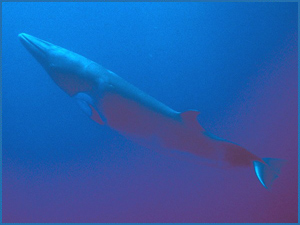Dwarf Minke Whale

Common Name: Dwarf Minke Whale
Scientific Name: Balaenoptera Acutorostrata
Dwarf Minke Whale - Description
The Dwarf Minke Whale is a small streamlined Baleen Whale with a maximum length of 10 metres. It has a sleek sharply pointed snout and a dorsal fin set well back on the body. There is a dark patch on either side of the throat, while the base of the flipper and shoulder are brilliant white. This whale has an inquisitive nature often approaching boats and people.
Dwarf Minke Whale - Diet
Food includes oceanic fishes and krill (shrimp-like animals which form enormous schools), which are engulfed within the pleated, highly expandable throat. The Dwarf Minke Whale appears to be more of a fish feeder than its southern friend the Antarctic Minke Whale (Balaenoptera bonaerensis) who predominantly feeds on krill.
Dwarf Minke Whale - Behaviour
Dwarf Minke Whales are active, highly manoeuvrable whales, which can swim at 12 knots for at least short bursts and may dive to at least 140 metres. Most sightings are of a single or pair, but groups of over 20 whales may occur around a boat during a single encounter. They are regularly seen breaching (jumping from the water) on the northern Great Barrier Reef. They are known to approach anchored or drifting vessels and may remain with the vessel and swimmers for several hours. They usually surface once for a breath and dive for periods from half a minute to nearly twelve minutes.
Dwarf Minke Whale - Habitat
Dwarf Minke Whales are very widespread but may have a complex population structure. Sightings suggest they have a more coastal distribution than Antarctic Minke Whales.
Dwarf Minke Whale - Special Features or Habits
The Dwarf Minke Whale has the most complex colour pattern of any Baleen Whale. The combination of colour patterns noted above conclusively identifies the Dwarf Minke Whale.
Dwarf Minke Whale - Location or Region Food
Known only from the Southern Hemisphere. Recorded from South Africa, Australia, New Zealand, New Caledonia and eastern coast of South America during the months March to December. There are scattered records from the sub-Antarctic during December to March.
 Deep Sea Crabs
Deep Sea Crabs